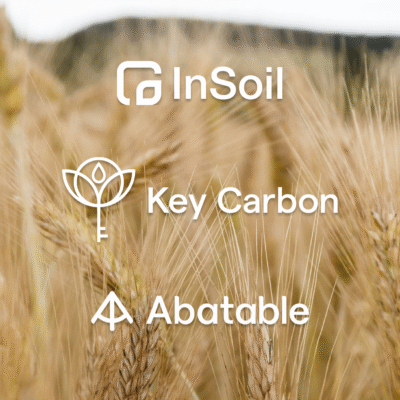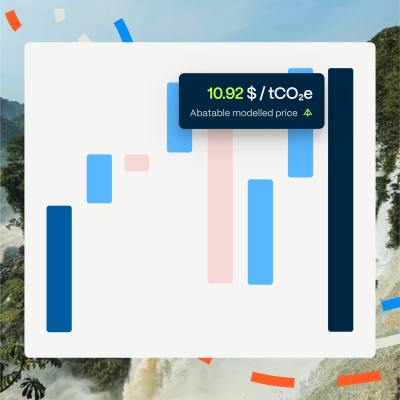Abatable’s Holly Nicholson unpacks the SBTi’s latest set of documents on the role of environment attribute certificates in company net-zero strategies and explains what they mean for businesses looking to take action on climate change. This blog is an abridged version of a market alert – a feature of our carbon market intelligence platform.
The Science Based Targets Initiative (SBTi) has been the leading framework and verifier for corporate emission reduction targets for the last decade. Set up in 2014 as a collaboration between CDP, the United Nations Global Compact, World Resources Institute and WWF, SBTi grew to launch its Corporate Net Zero Standard (CNZS) in October 2021.
This CNZS has subsequently become considered the north star for many Paris-aligned net-zero strategies, and includes four key components:
- The setting of short-term emission reduction targets with the aim of halving emissions by 2030
- The setting of long-term targets requiring a reduction of value chain emissions of around 90% by 2050
- The use of carbon removal credits to neutralise around 10% of unabated emissions by 2050
- A recommendation to invest in Beyond Value Chain Mitigation (BVCM) following the above actions, which includes the use of carbon credits
Under CNZS, value chain emissions cover Scope 1, 2, and 3 emissions, and SBTi requires 67% of Scope 3 emissions to be included in a corporation’s boundary for short-term (2030) targets, and 90% for long-term (2050) targets.
BVCM covers investments in carbon reductions and removals (e.g. carbon credits) that occur outside a company’s value chain. Reductions do not count toward net zero under the CNZS. The concept of BVCM is associated with emerging corporate climate action strategies, including contribution claims, which are distinct from carbon neutrality claims.
CNSZ outlines the steep hill companies need to climb to reach net zero. This hill becomes a mountain when considering Scope 3 which, in most cases, makes up the lion’s share of value chain emissions. Most Scope 3 emissions are from a company’s suppliers or customers, resulting in reduced control over reducing them and, thus, reaching net zero unde CNSZ.
Recognising this challenge, SBTi has begun to overhaul CNZS. Debates regarding how to address Scope 3 emissions, and where tools like carbon credits can play a role, have intensified in 2024. With diverse opinions from SBTi stakeholders, including its staff, funders, and partners, the group faces the challenge of considering these views while creating a straightforward and urgent framework necessary for companies to set achievable net-zero targets and take meaningful action for the climate.
A first step
SBTi released the much-anticipated first outputs as part of this overhaul of its CNZS on 30 July. As part of the release, a discussion paper on Scope 3 target setting was published, providing insight into some potential pathways the SBTi may be heading towards when it comes to net-zero targets and carbon credits.
The paper comprised two key elements:
The introduction of outcome or alignment-based metrics
This suggests that SBTi could shift its focus purely on emission reduction metrics towards considering other activities that support the climate transition – which many argue are essential for meeting global climate goals.
Such metrics could include the percentage of suppliers with SBTi targets, or the share of low-carbon materials used in production.
Five scenarios in which Environmental Attribute Certificates (EACs) could play a role in the new CNZS
SBTi categorises EACs into two groups: carbon credits and commodity certificates. Below, we provide an overview of these EACs and the scenarios in which they could play a role, as presented by SBTi.
Defining EACs
Under SBTi, commodity certificates are defined as Instruments that certify and convey sustainability information about the production of a commodity.
Examples include energy certificates, which include Renewable Energy Certificates (RECs), green hydrogen certificates, or Sustainable Aviation Fuel (SAF) certificates; agricultural commodity certificates that support environmental claims like zero-deforestation; and industrial commodity certificates that verify that materials such as metals have been produced sustainably.
Commodity certificates are a new categorisation by SBTi.
SBTi defines carbon credits as tradable units representing the reduction of one tonne of carbon dioxide equivalent from the atmosphere. Examples include avoided emission credits (e.g. renewable energy); emission reduction credits (e.g. energy efficiency); and carbon removal credits (e.g. afforestation).
Scenarios presented by SBTi: commodity certificates
Scenario 1: Use of commodity certificates from value chain activities
Commodity certificates include energy certificates (covering, for example, the production of green hydrogen or Sustainable Aviation Fuel) alongside agricultural or industrial commodity certificates. These agricultural or industrial certificates are defined as certifications that affirm the sustainable or green production of a particular commodity. In our view, insets likely fit this definition, which would permit corporates to prove that purchased goods have reduced Scope 3 emissions.
Scenario 2: Use of commodity certificates from sources with lower or no value chain traceability
SBTi is exploring the potential to allow commodity certificates outside of the value chain in situations where the commodity cannot be directly linked to a corporate supply chain. It references the work of the Advanced and Indirect Mitigation (AIM) Platform, which is developing value chain intervention guidance alongside SBTi and GHG Protocol.
In its current form, the guidance would allow companies to claim value chain emission reductions from suppliers outside of their Scope 3 inventories. In cases where an intervention cannot be traced within a Scope 3 physical boundary, corporates could claim emission reductions from suppliers that are either closely associated with the corporates’ supply chain (e.g. in a similar geography) or, failing that, suppliers within a sector that the corporate sources from.
While this approach addresses the challenges corporations with complex supply chains could face when implementing insetting projects, it also raises questions about traceability and accepted boundaries, and how to prevent issues like double counting of the emission reductions associated with an intervention or insetting project.
Scenarios presented by SBTi: carbon credits
Scenario 3: Use of carbon credits from mitigation activities within the value chain
The third scenario alludes to insetting practices but with carbon credits rather than commodity certificates. Here, a company would develop or buy carbon credits from a project (including emission reduction, avoidance and removal credits) within its value chain.
SBTi notes that this practice would require some refinement but that standards are being developed by organisations such as the Value Chain Initiative, Verra, and Gold Standard. The question of traceability and boundaries, particularly for companies with complex supply chains, as explained above, is also an open question under this scenario.
Scenario 4: Use of carbon credits to support the neutralisation of residual emissions
The current CNZS already permits the use of removal carbon credits to address residual emissions. These are usually allowed for 10% of total value chain emissions, which SBTi deems to be outside of the minimum boundary (long-term target). The SBTi is working to develop further guidance on removals, including matching emissions with particular removal storage types and timescales. One area of uncertainty is how removals are considered either within or outside of the value chain, which would have an impact on how removals for neutralisation compare to Beyond Value Chain Mitigation (BVCM).
Scenario 5: Use of carbon credits to support BVCM
As with Scenario 4, SBTi has already explored and provided guidance on BVCM, with carbon credits considered an additional BVCM measure that does not count toward net-zero targets. However, SBTi is considering the role BVCM could have in addressing the uncertainty around Scope 3 boundaries.
Currently, 67% of Scope 3 emissions are included in short-term targets, which should expand to 100% for long-term targets. SBTi presents an example (see Figure 1) in which a company purchases credits as a BVCM measure to cover the remaining 33% of Scope 3 emissions excluded from the target boundary. This is then phased out over time, as the corporation steps up neutralisation and value chain abatement (which could include credits under Scenario 3). While this approach would set an incentive for corporates to invest in carbon credits, it again raises questions about how removals as neutralisation will be defined compared to BVCM efforts.

Figure 1. Illustrative example of a scenario where companies are incentivized to abate Scope 3 emissions, neutralise residual emissions and finance mitigation outside their value chain
Source: Graphic from SBTi’s Scope 3 discussion paper
Opportunities and outstanding questions
These scenarios could be perceived as a middle ground between those who support EACs and others who feel they have no or limited space in the CNZS. SBTi has presented a number of opportunities to companies to contribute to meaningful climate action beyond direct emission reductions. These include:
- The use of alignment-based metrics to recognise companies taking climate-friendly steps within supply chains, even if they do not translate into Scope 3 emission reductions
- The ability to contribute to BVCM and invest in carbon credits to cover 33% of Scope 3 emissions, which may be phased out over time (Scenario 5)
- The recognition of insetting activities, either through commodity certificates (Scenarios 1, 2) or by purchasing carbon credits within a value chain (Scenario 3)
There are also a number of topics the SBTi may benefit from expanding on or defining in the upcoming draft CNZS, expected to be released at the end of 2024. These include:
- Defining and expanding upon the role of insetting. Scenarios 1, 2, and 3 allude to insetting practices, but the word insetting is not used in the document. As explored in Abatable’s recent report with the International Platform on Insetting, while the practice has the potential to offer climate, social, and supply chain resilience benefits, insetting is an area that currently suffers from a lack of guidance and widely accepted standards, which could lead to traceability issues such as discussed in Scenario 2.
- There is no discussion of concepts such as internal carbon pricing or money-for-tonne BVCM, as was introduced in the SBTi’s BVCM guidance as an internal incentive to reduce value chain emissions. While the proposed alignment-based targets could help address some key challenges in Scope 3 target setting, SBTi may overlook impactful incentives and structures, such as internal carbon pricing, that could help reduce actual value chain emissions.
- It is also unclear how a shift to alignment-based metrics would fit with regulatory requirements such as emission disclosures or compliance carbon pricing. Companies may be deterred from engaging with CNZS if their regulatory compliance or contribution or BVCM claims are not considered, or do not count toward SBTi target achievement.
Overall, SBTi’s latest discussion paper summarises what, in our view, is a compromise position, informed by inconclusive insights from the consultation on the use of EACs and the media backlash following the SBTi Board of Trustees’s statement in April 2024 suggesting that EACs, including carbon credits, could be used for abatement purposes for Scope 3 emission reduction targets.
A shift of focus to alignment or outcome metrics, and a lack of consideration for incentives like internal carbon pricing or ongoing carbon pricing regulatory efforts by countries, could lead to downsized corporate engagement and could inadvertently lead to a decrease in support for climate action.
Next steps
Stakeholders are invited to share feedback on SBTi’s Scope 3 discussion paper via an online form, with submissions due by 12 September 2024. The form largely focuses on the SBTi’s proposals for alignment targets, including whether to consider both alignment and emission reduction targets, or only one of these. SBTi is also seeking responses on additional considerations for the five scenarios for EAC use.
The draft CNZS is intended to be released for consultation at the end of 2024. Some stakeholders have expressed frustration at the delayed timeline, as it could take another six to 12 months for the final CNZS to be released.
The SBTi NZCS revision timeline will likely align with the ongoing consultations at the GHG Protocol, which recently released the results of its consultation on market-based mechanisms. Since GHG Protocol guidelines underpin the carbon accounting methods taken by SBTi companies to set targets, the two organisations will benefit by aiming for alignment.
The SBTi’s suggestions offer some practical suggestions for the use of EACs, including carbon credits, in corporate climate strategies. However, with the outlined timelines, it will be halfway through the so-called ‘decade of action’ on climate change for concrete Scope 3 guidance from the world’s most-followed corporate climate action arbiter.
This blog is an edited version of a previous Abatable market alert, available for Abatable market intelligence subscribers. Find out more about Abatable’s market intelligence services here.

































































































